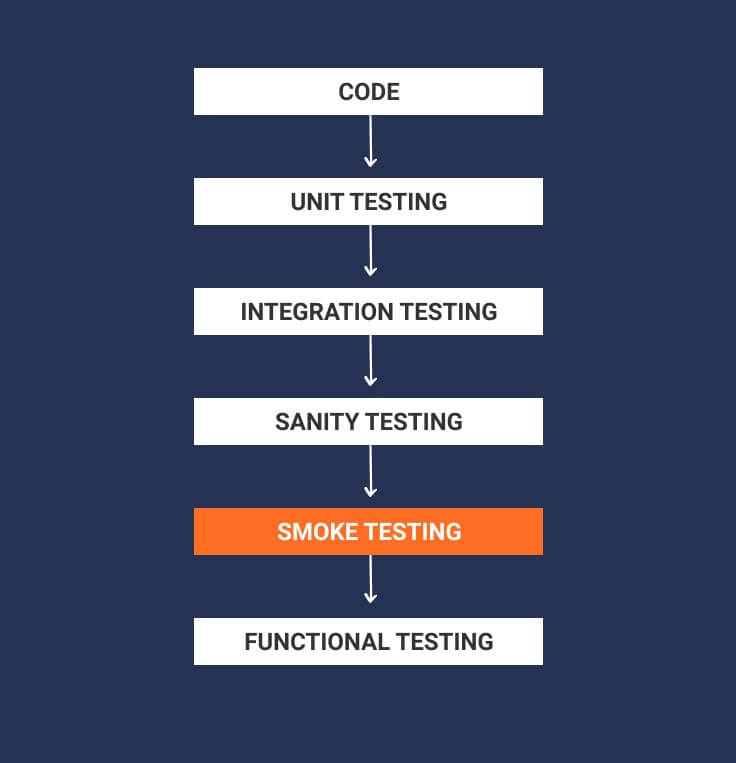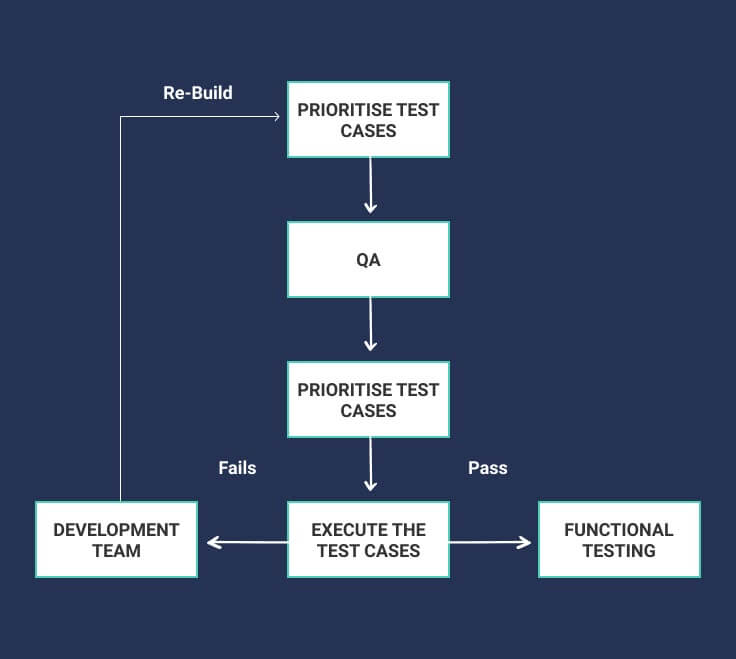In the world of computer programming and software testing, smoke testing is also referred to as Build Verification Testing (BVT), Build Acceptance Test, and Confidence Testing. We can say it is initial or preliminary testing to reveal simple failures. Microsoft claims that
“ Smoke Testing is the most cost-effective method for identifying and fixing defects in software “
Let us have some brief ideas from the definition of Smoke Testing.
What is Smoke Testing?
Smoke Testing is a software testing technique that determines whether the deployed software under test is ready/stable for further testing.
It executes before the regression and functional testing. Thus, smoke Testing confirms the Quality Assurance (QA) team to proceed with further software testing methods. Smoke Testing consists of very few test sets that run on each software build to test software functionalities. Due to this reason, Smoke Testing is also known as Build Verification Testing and Build Acceptance Testing.
As a simple definition of smoke testing, we are checking whether the essential features of the software are working or not, and there are no issues in the software build that is under testing.
It is a small and rapid regression test for the essential functionalities. It is one of the simplest tests, which shows that the software is ready for further testing. From smoke testing, we can quickly know the build can be further tested or not.
Smoke Testing qualifies the software builds for different types of testing. The main aim of this software testing method is to detect issues in the early stage of the Software Testing Life Cycle (STLC). In addition, smoke tests are designed to confirm the system’s stability and requirements.
A build includes all libraries, data files, engineered components, and reusable modules needed to implement different functions of the software products.
Every software testing method has its characteristics, and so does smoke testing. Here are the characteristics of smoke testing.
Characteristics of Smoke Testing
- It is always documented.
- It can be stable as well as unstable.
- It is usually scripted.
- It is a type of regression testing.
- Smoke Tests are usually quick to run.
- Smoke Tests are generally automated.
- Smoke Test covers the broader functionality of the software.
- It can be performed by software developers, software testers, or by QA engineers.
When to do Smoke Testing?
Smoke Testing is done when there is the addition of new functionality in software. It is also conducted when integrating new builds with the existing ones in the QA/Staging environment. Smoke Test ensures that all the functionalities are working correctly or not.
In this software testing method, the software development team deploys the build in the Quality Assurance (QA). The subsets of test cases are picked, and then the software testing team runs test cases on that build. The testing and QA team test the software application against the critical functionalities. There are a series of test cases designed to detect the errors from the build. If the test passes, QA and Testing teams continue with functional testing and then regression testing.
In case of failure, the application is handed back to the software development team. Whenever there is any change in the build, there is a need to do smoke testing to ensure the stability of that build.
Example:- A new login and signup buttons are added in a form, and a build is deployed with the code changes. Then we need to perform smoke testing on that build.
Who Can do Smoke Testing?
After deploying the software build into the QA environment, It is generally done by the software testing team/QA engineers/QA lead. Whenever there is any new build in the application, the QA team considers the important functionalities of the software to perform smoke testing. QA team checks for bugs and issues in the application that is under smoke test.
Why Smoke Testing?
Smoke Testing plays a vital role in software development as it verifies the accuracy of software systems in their initial stages. By conducting smoke tests, we can save lots of time and test efforts. As a result, smoke testing is needed to bring the system into a good state. Besides, other types of testing can begin only after a successful smoke test. Apart from this, here are the other reasons to conduct smoke testing.
- By performing a smoke test, all the bugs and show stoppers are discovered.
- It is needed to identify the defects in the initial stage of development.
- By conducting smoke testing, we can easily simplify the detection and correction of the majority of defects.
- Smoke testing helps the QA team to find errors in functionality that may have occurred due to code change.
- It is carried out to check system stability.
- It is done for the conformance of requirements.
- It is conducted to check the overall functionality of the software.
How to do Smoke Testing?
There are mainly two types of smoke testing techniques. Manual smoke testing and automated smoke testing. Though smoke testing is generally done manually, there is the possibility of conducting it through automation. While testing may vary from software testing companies to the requirement of software testing projects. Let us understand both types of smoke testing in brief.
Manual Smoke Testing
Generally, Smoke Testing is done manually. Its approach varies from one software testing company to another. It ensures that navigation and flow of the application are as expected and functionalities are up to date or not.
As soon as the build is deployed in QA, priority-wise functionalities are tested to find defects in the system. If the test is successful, it can further proceed for functional testing. But If the testing fails, then the build is sent back to the software development team for corrections. After changes are done, the QA team again starts with smoke testing on the system’s latest version. Smoke Testing is performed on the latest build and then the tested build is integrated with previously tested builds.
Automated Smoke Testing
Automation Testing is generally used for Regression Testing. However, you can also design a set of automated test cases for the Smoke Test. Whenever there is a new build deployed, software developers can check it immediately with the help of Automated Smoke Testing.
Instead of repeating all the test cases manually, recorded cases of the smoke test are repeated whenever a new build is deployed. It checks whether the functionalities are working fine or not. In case if the automated testing fails, then the builds are corrected and immediately redeployed. By using automated smoke testing, we can save a lot of time and effort and ensure a quality build.
Smoke Testing Life Cycle
The below flowchart shows the complete life cycle of Smoke Testing. As soon as the build is deployed in the QA environment, test cases are executed on it. If the test cases are pass then the build further proceeds for functional and regression testing. But if the build fails, then it is sent back to the development team to fix it. This Smoke Testing Cycle continues until all the issues in the build are resolved.
Using automated tools in smoke testing, software testers can record all the necessary steps in manual testing and perform that automatically. Here is is the list of top smoke testing tools.
Advantages of Smoke Testing
Here are few listed advantages of smoke testing.
- Smoke Testing is straightforward to perform.
- It identifies the defects in the early stage.
- It improves the quality of the overall software system.
- It reduces the risk.
- Tracking progress becomes effortless.
- It saves a lot of testing time, effort, and resources.
- It quickly detects critical errors.
- Correcting the detected errors becomes easy through smoke testing.
- Smoke Testing runs quickly.
- It minimizes the integration risks.
Smoke Test Cases Examples
Here are smoke test case scenarios or you can say smoke testing examples.
| Test ID | Description | Steps | Expected Outcome | Actual Outcome | Status |
| 01 | To verify login functionality. | 1. Launch the app. 2. Visit the login page. 3. Enter login credentials. 4. Click Login. |
Login Successful | Login Successful | Pass |
| 02 | To verify video play functionality. | 1. Go to the video page. 2. Play the video. |
Video Starts playing. | The video player does not pop up. | Fail |
Smoke Testing vs. Sanity Testing
Smoke Testing Vs. Sanity Testing is one of the most conducive topics in software testing. There is a lot of literature on this topic and most of it is unclear. So here are the clear difference between smoke testing and sanity testing.
| Smoke Testing | Sanity Testing |
| Smoke Testing is performed to verify that critical functionalities of the software are working fine. | Sanity Testing is performed to confirm that newly added functionalities and detected bugs of the software are fixed. |
| This software testing method aims to verify the “stability” of the software system. | This software testing method aims to verify the “rationality” of the software system. |
| This testing is performed by testers and developers. | This testing is usually performed by testers only. |
| Smoke Testing is generally scripted and documented. | Sanity Testing is neither scripted nor documented. |
| Smoke Testing can be said as a subset of Acceptance testing. | Sanity Testing can be said as a subset of Regression Testing. |
| Smoke Testing is focused on end to end on the entire system. | Sanity Testing is focused on particular functionalities of the system. |
| An appropriate set of test cases are created here. | It may not be possible every time to create a test case here, so rough test cases are used here. |
| It is broad and deep testing | It is broad and shallow testing. |
Concluding Thought
By now, you will be having a clear idea about smoke testing and how it is different from sanity testing. Any software or product needs quality assurance and testing to avoid real-time issues. This is sometimes necessary to improve the overall quality and performance of tools and software you use daily.
For any type of QA & Testing, feel free to approach us. Our years of experience have proven us as one of the most trustworthy software testing service providers in the US and other countries worldwide. For all types of testing and its related service, contact us.
Besides that, feel free to share your thoughts in the comment section below!
COMMENT
No Comments found.
DETAILED INDUSTRY GUIDES
Software Development - Step by step guide for 2021 and
beyond | OpenXcell
Learn everything about Software Development, its types, methodologies, process outsourcing with our complete guide to software development.
Headless CMS - The complete guide for 2021 | OpenXcell
Learn everything about Headless CMS along with CMS, its types, pros & cons as well as use cases, and real-life examples in a complete guide.
Mobile App Development - Step by step guide for 2021 and beyond | OpenXcell
Building your perfect app requires planning and effort. This guide is a compilation of best mobile app development resources across the web.
DevOps - A complete roadmap for software transformation | OpenXcell
What is DevOps? A combination of cultural philosophy, practices, and tools that integrate and automate between software development and the IT operations team.
GET QUOTE
INSIGHTS INTO TECH
The inception of ChatGPT in 2022 marked the wide-scale adoption of Artificial Intelligence in application development. In the field of creating mobile apps, AI-powered tools and frameworks have become indispensable…
Read more...
Introduction Most industries have turned to AI to stay ahead of the competition in the evolving tech landscape. The construction industry is no stranger to this trend. The advent of…
Read more...
Introduction Digital transformation needs no introduction; it is evolving as a norm in many industries. The paradigm transition it brings to the retail landscape is evident from the latest predictions.…
Read more...








